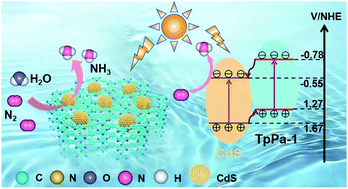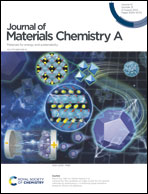Anchoring ultrafine CdS nanoparticles in TpPa-1-COF: a type II heterojunction for enhanced photocatalytic N2 fixation†
Abstract
To alleviate energy and environmental issues, photocatalytic nitrogen fixation to ammonia is a promising technique compared to the conventional Haber–Bosch process. In the present work, a CdS/TpPa-1 heterojunction was constructed by the in situ formation of ultrafine CdS nanoparticles in the TpPa-1-COF matrix. The NH3 production rates over the as-obtained CdS/TpPa-1 samples with different contents of CdS were optimized, and the highest rate was up to 241 μmol g−1 h−1 under visible light in the absence of sacrificial agents and cocatalysts, which was 3.0 and 1.7 times that of pure CdS and TpPa-1. The isotope labeled 15N2 gas was used as the nitrogen source for photocatalytic nitrogen fixation to clarify the source of nitrogen in ammonia, and the result indicated that the nitrogen source for ammonia was N2 gas. The charge transfer mechanism of CdS/TpPa-1 was consistent with that of the type II heterojunction, which was verified by in situ X-ray photoelectron spectroscopy (XPS). Besides, the reaction mechanism of N2 to NH3 was analyzed by in situ diffuse reflectance infrared Fourier transform spectroscopy (DRIFTS) and density functional theory (DFT) calculations, and the alternating mechanism was energetically more likely to occur than the distal mechanism. This work may provide a valuable route to construct COF-based heterojunctions for efficient photocatalytic N2 fixation.

- This article is part of the themed collection: Journal of Materials Chemistry A HOT Papers


 Please wait while we load your content...
Please wait while we load your content...